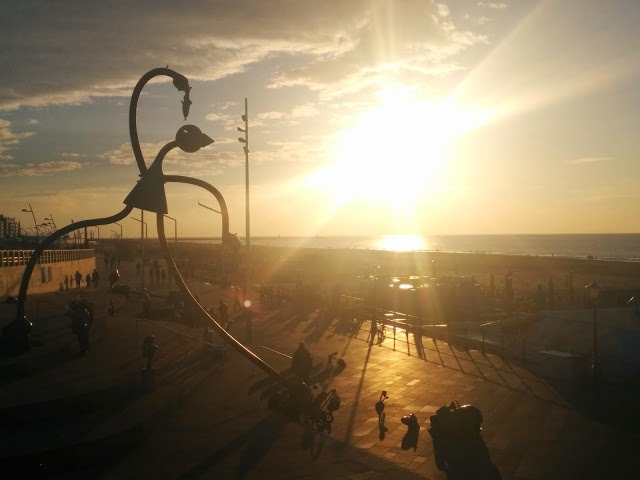Image credit: NASA Goddard Space Flight Centre photostream

This newsletter was originally published via email on the 21st February 2016. You can also sign up to receive Ice Cream Sundae with the form on the right hand column or here (The newsletter format shifted from long to shorter form since).
After some consideration for this week’s topic I started thinking about strengths, what I’m good at.
More specifically, you may have heard of Gallup’s Strengthsfinder (If you haven’t I’ll tell you about it now). Gallup is a management consulting company, and they are particularly known for their opinion polls. One of their founders also came up with this idea of analysing the data from over a million one on one in-depth interviews with professionals from just about every field you can imagine and turned it into Strengthsfinder.
The premise is pretty simple: rather than spending so much time and energy in our lives on what we are not good at, let’s focus on our strengths instead.
Out of their research, they identified and developed 34 of what they’re calling “strength themes”. For the most part, the themes are described and organised differently from the way we usually think of strengths. They’re both interesting and thought provoking.
You can take an online test and they tell you what your top five strengths are. There’s also an option to unveil the order of all 34 themes. I’ve done both. I’d say the top five is entirely sufficient to begin with.
As an experiment, I thought it could be fun to start a short strengths series to write about mine and attempt to illustrate them in writing.
I probably won’t do the five in a row; I’ll come back to it whenever I feel is appropriate.
Let’s start with my top strength: Ideation.
I took the test once with the first edition in 2006 and then a few years later when the 2nd edition of the book was published in 2010. Both times ideation came out first.
In case you’re wondering if ideation is a proper word, it’s both in the Oxford and Merriam-Webster dictionaries.
From the Gallup Strengthsfinder the Ideation theme is described as such:
“People exceptionally talented in the ideation theme are fascinated by ideas. They are able to find connections between seemingly disparate phenomena.”
A friend who reads this newsletter told me he particularly enjoys the way in which I jump from one topic to another and then tie them together.
I make these connections as I’m writing and I’m not planning them half the time, they just come naturally.
The word idea has Greek roots, and means form, or pattern.
One of the dictionary definitions for idea is a thought, plan, or suggestion about what to do.
By now, you might already have the image of a light bulb come to mind.
Unless I just turned that light bulb on by writing it and you reading?
I’m not sure where it comes from, though signs point to the inventiveness and popularity of Edison when he invented the light bulb, often represented above him in photography portraits.
This was popularised even further in cartoons and then animations, with symbols representing characters’ thoughts and emotions. I read this interesting article that specifically attributes the light bulb idea to the animated character Felix the Cat. It’s an interesting theory though I think drawn cartoon characters with ideas likely came first. I don’t have any proof, it’s just an opinion.
Edison’s light bulbs were all the rage at the turn of the twentieth century. If you wonder what they look like, I’m pretty certain you’ve seen one recently. A hundred years later, they have made a serious comeback and are totally in fashion now. Almost every new popular bar and restaurant features large Edison lights. They’re the ones with complex and winding filaments, lit in a warm deep yellow or orange glow. For some reason most of the recent coffee shops, microbrewery pubs and trendy bars feature these kinds of lights.
It’s ironic given these light bulbs had been generally phased out because they were wasteful and didn’t produce as much light as following generations of light bulbs. We now have super long lasting and energy saving light bulbs but we’ve reverted to the old school Edison lights. That said most of them are probably the LED kind; they replicate the same shapes and style without being as wasteful from an energy perspective
I doubt a secret conclave of hospitality professionals and interior designers met and voted on the implementation of Edison light bulbs as a trend to bring back, though it is interesting to see how we imitate and reproduce what seems to be working for others.
Mimicry is one of the ways human beings learn. I’m seeing it closely at the moment with my toddler nephew; he’s quickly improving at repeating words and names he hears.
It may be one of the ways we learn, though we generally think of something new with the word idea. Repetition and ideas aren’t necessarily exact opposites but they’re certainly not synonyms either.
Ideas also hold a notion of appearing out of thin air, suddenly. Maybe in the same way flicking a switch magically turns a light bulb on. It’s not actual magic of course; among other reasons it looks like it because light travels so fast our naked eyes can’t see it.
Growing up in France, in Chemistry class I learned Lavoisier’s Law: “Nothing is lost, nothing is created, everything is transformed”
Antoine Lavoisier was a chemist in the late 18th century generally considered “the father of modern chemistry”. His statement was meaning to show that however matter changes state, the total mass of matter remains the same. I believe it’s also known as the law of conservation of mass. Like the experiment in the second film adaptation of Paul Auster’s New York Trilogy, Smoke, when the main protagonists who frequent the same tobacco shop in Brooklyn burn a cigarette, weight the remaining ash to try and deduce the weight of smoke (if I remember correctly). If you include the mass of the smoke and other residue regardless of their physical state, the total mass should be the same.
I believe something along the same lines happens with ideas.
We like to think new ideas are born all of a sudden and out of nowhere, but they’re more likely to be a product of all sorts of stuff coming from existing knowledge and previous experiences. Half the time we just don’t realise where these idea components come from.
I use the word stuff purposefully. I like it.
I just wondered why and checked the definition.
- Matter, material, articles, or activities of a specified or indeterminate kind that are being referred to, indicated, or implied.
- The basic constituents or characteristics of something or someone.
It’s basically all-inclusive. A magic word I can use to replace almost any other word.
Just be careful not to become lazy to think about the most appropriate word and overusing this one, turning it from magic into mush, or smurf. This could be a topic to explore another time.
The Edison light bulbs in most of the restaurants I mentioned earlier dangle from long wires.
Consider this for a second; these light bulbs look like big lollipops turned upside down.
They are probably lemon or honey flavoured given their warm yellow glow.
The thought of lemons just reminded me of the citrus smells from orange and lemon trees in the streets of Seville I visited for a weekend years ago, before the Edison lights were so trendy.
Lemon was never my favourite lollipop flavour though.
When I was growing up I’d go to the village’s boulangerie to buy candy, they both had the traditional Pierrot Gourmand lollipops and the now more famous Chupa Chups brand too.
I’d generally choose the cherry flavour if they had it.
When I moved to France, the first house we lived in had a huge garden with many fruit trees, including two cherry ones. We picked the fruits and ate them straight from the tree when they were in season.
If you hold a cherry by the stem, you could imagine it’s a red Edison light bulb, in a trendy restaurant hanging from a wire.
It could be a cool look for a fruit smoothie and juice bar.
And of course cherries are a traditional topping to complete an ice cream sundae.
Everything comes from something we’ve experienced, never out of thin air.
From this perspective the new is a blend of several old we had all but forgotten about.
We naturally collect and regurgitate information, experiences and sensations in newly transformed states.
Apparently I can do that particularly well.
I certainly leverage this strength in my job.
Leading and participating in creative brainstorming sessions is something I really enjoy about being a strategist. Being in a room of people firing new ideas is energizing and compelling. It’s rich in ways that are difficult to discern while we dwell in this space of uncertainty where there are no bad answers and no concept is too silly.
The key however is to not lose sight of an agreed upon objective, without that it’s impossible to consider the quality of any given idea. Without a goal, ideas are just pointless ramblings about lollipops and Edison light bulbs.
The mush isn’t that far away from the magic.
My first step as a strategist is to ask questions that will help define my clients’ objectives.
It’s the best advice I can give you if you’re interested in coming with new ideas: first determine what your objective is. That becomes the framework your ideas can be developed in and out of, the proverbial box you can now think out of.
It’s possible that this combining of traditional ideas into something is what I found fascinating about Sensible Object studio’s new game project on Kickstarter. Fabulous Beasts blends components of a physical balancing board game with digital elements of a world-building video game. I had the chance of meeting with Tim Burrell-Saward for an interview I published on my podcast this week, it was a fun conversation to find out about the game and their inspiration, though unfortunately there were some issues with the recording and I decided to cut a few parts of it. I’m still learning to use my audio equipment correctly and I need to invest in a new digital recorder for these cases when I meet interviewees in person.
I also got round to writing a short post about the quality of the advertising and sponsored messages in Gimlet media’s podcasts, and the way they talk about it in a few different episodes of their brilliant podcast, StartUp.
I’ve also started publishing the Ice Cream Sundae newsletter more widely online, in my blog as well as on Medium, so that more people can discover and read it. This won’t change anything to what you receive in your inbox every week, I’ll repost it online a little later so you still get to read it first if you’re signed up to the email list.
If you’re enjoyed reading this and you think a friend of yours will enjoy it too, forward it along.
If you find out about your Gallup strengths, I’d love to hear what they are, send me a reply via email, or you can also get in touch via Facebook or Twitter.
Have a great week!
Best,
Willem


